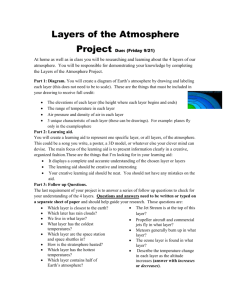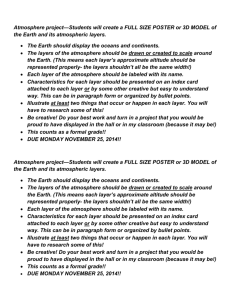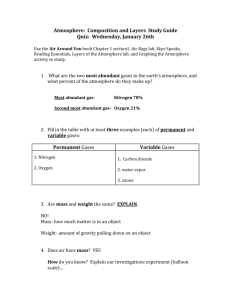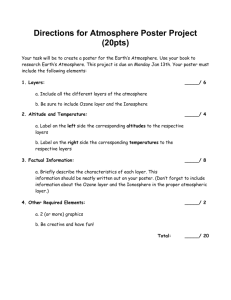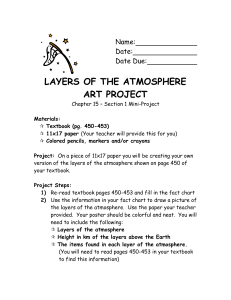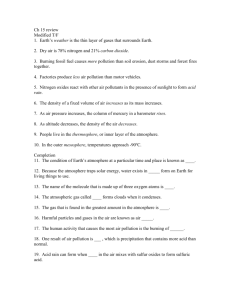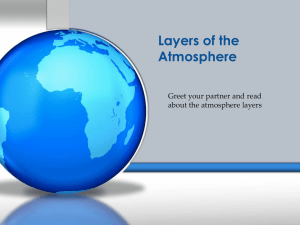E.FE.07.12 Win 12
advertisement
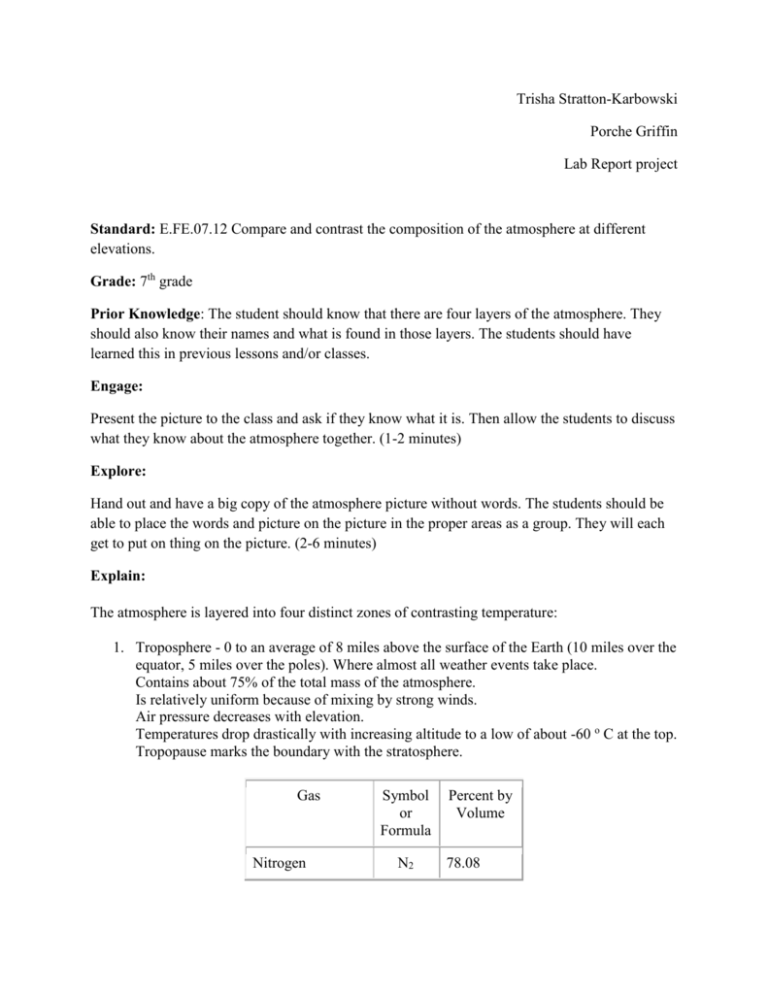
Trisha Stratton-Karbowski Porche Griffin Lab Report project Standard: E.FE.07.12 Compare and contrast the composition of the atmosphere at different elevations. Grade: 7th grade Prior Knowledge: The student should know that there are four layers of the atmosphere. They should also know their names and what is found in those layers. The students should have learned this in previous lessons and/or classes. Engage: Present the picture to the class and ask if they know what it is. Then allow the students to discuss what they know about the atmosphere together. (1-2 minutes) Explore: Hand out and have a big copy of the atmosphere picture without words. The students should be able to place the words and picture on the picture in the proper areas as a group. They will each get to put on thing on the picture. (2-6 minutes) Explain: The atmosphere is layered into four distinct zones of contrasting temperature: 1. Troposphere - 0 to an average of 8 miles above the surface of the Earth (10 miles over the equator, 5 miles over the poles). Where almost all weather events take place. Contains about 75% of the total mass of the atmosphere. Is relatively uniform because of mixing by strong winds. Air pressure decreases with elevation. Temperatures drop drastically with increasing altitude to a low of about -60 o C at the top. Tropopause marks the boundary with the stratosphere. Gas Nitrogen Symbol or Formula N2 Percent by Volume 78.08 Oxygen O2 20.94 Argon Ar 0.934 Carbon Dioxide CO2 0.035 Neon Ne 0.00182 Helium He 0.00052 Methane CH4 0.00015 Krypton Kr 0.00011 Hydrogen H2 0.00005 Nitrous oxide N20 0.00005 Xenon Xe 0.000009 2. Stratosphere - extends from the tropopause up to about 50 km (31 mi). Air temperature is stable or increases with altitude. More dilute than troposphere but with similar composition except for two important components: water and ozone (O3). Water vapor is lower but ozone levels are much higher than in the troposhere. Relatively calm with little mixing. Contaminants can remain in suspension for many years. 3. Mesosphere - extends from about 50 km to about 80 km. Temperatures decrease again with altitude to a low of about -80 oC (-120oF). 4. Thermosphere - begins at about 80 km. A region of highly ionized gases extending out to about 1,600 km (1,000 mi). Temperatures are very high due to constant bombardment of molecules by high-energy solar and cosmic radiation. Lower part of this layer is called the ionosphere. This is where the aurora borealis or northern lights appear. Elaborate: To help the students grasp the idea of the atmospheres layers and the composition of each they will complete a paper display in groups of two. This will show that they can remember the information and where it goes in the atmosphere. This display will include Earth, troposphere, stratosphere, mesosphere, thermosphere, and the composition of each (not including Earth’s). 1. Start with a black/ white piece of paper. Also have a red, green, blue, pink, and orange. 2. Each color represents a layer of the atmosphere( Green is Earth) Red = the warmest layer of the atmosphere. Pink = the next warmest layer of the atmosphere. Orange= the 3rd warmest layer of the atmosphere. Blue= the coldest layer of the atmosphere. 3. Cut out the colored paper above to fit with your black/white piece. Remember it must be approximately proportional to the actual altitude of the layers. For example, Earth is smaller than the troposphere and so on. It does not need to be exact! 4. Use a glue stick to put the colored paper in order on your black/ white sheet of paper. 5. Label each layer and the Earth along with the composition of each layer in marker on the layers of atmosphere. 6. Make sure you do a neat job on the display! Evaluate: This is the part where discussion question would be asked. 1. What is one thing that you learned? 2. When will this information learned be used in your everyday life? Work cited: http://facstaff.gpc.edu/~pgore/Earth&Space/GPS/Earth-systems.html http://www.ucar.edu/learn/1_1_1.htm http://www.crayola.com/lesson-plans/detail/lifesaving-layers%E2%80%94earth%E2%80%99satmosphere-lesson-plan/ LIFESAVER ATMOSPHERE! 1. Start with a black/ white piece of paper. Also have a red, green, blue, pink, and orange. 2. Each color represents a layer of the atmosphere( Green is Earth) Red = the warmest layer of the atmosphere. Pink = the next warmest layer of the atmosphere. Orange= the 3rd warmest layer of the atmosphere. Blue= the coldest layer of the atmosphere. 3. Cut out the colored paper above to fit with your black/white piece. Remember it must be approximately proportional to the actual altitude of the layers. For example, Earth is smaller than the troposphere and so on. It does not need to be exact! Space Earth 4. Use a glue stick to put the colored paper in order on your black/ white sheet of paper. 5. Label each layer and the Earth along with the composition of each layer in marker on the layers of atmosphere. 6. Make sure you do a neat job on the display!

